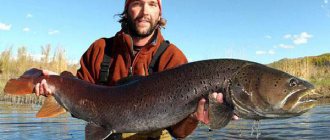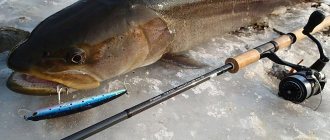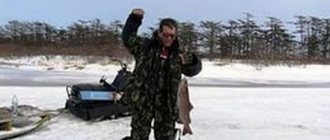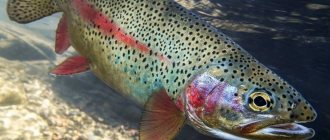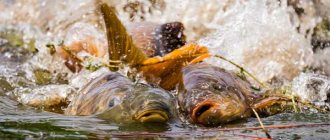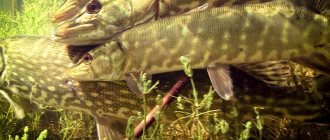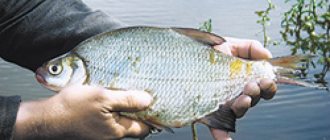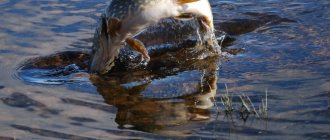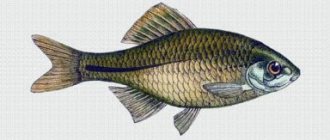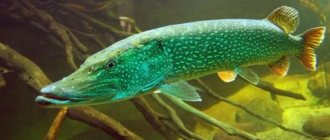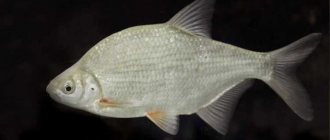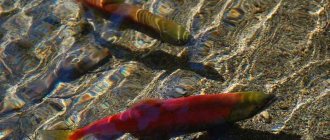Description of the species
Taimen, Siberian taimen or common taimen (Hucho taimen) - belongs to the genus of taimen of the salmon family (Salmonidae) and is its largest representative.
The taimen genus includes several species:
- Common taimen, or taimen (Hucho taimen)
- Danube taimen (Hucho hucho)
- Korean taimen (Hucho ishikawae)
- Sichuan taimen (Hucho bleekeri)
- Mityagin taimen (Hucho Mityagin)
- Sakhalin taimen (Hucho perryi)
You can find several names for taimen: Siberian taimen, Siberian giant trout, talmen, krasulya, laziness. Local residents sometimes use the name red pike, since before the spawning period in the spring, adult taimen add bright copper-red and orange colors to their color.
As a result of studies of the structure of the genotype, scientists came to the conclusion that taimen is one of the oldest salmon fish, which is more than 40 million years old on Earth. A close family relationship has been established between freshwater taimen and Pacific salmon of the genus Oncorhynchus and noble Pacific salmon of the genus Parasalmo.
Common taimen is distinguished by its maximum size and weight among all salmon. It does not have a hypo-osmotic mechanism that allows it to remain in salty sea water, so taimen leads an exclusively freshwater lifestyle.
Habitats and lifestyle of taimen
Taimen lives in fresh, flowing, cold-water lakes and rivers, never going out to sea. More often, taimen can be found in fast small rivers with cool, clean water. In Russia, taimen is found over a fairly wide area: from the Urals to the south of the Far East and east of Yakutia. Taimen is a predatory fish; it feeds on roach, perch, minnows, grayling and other fish. The fertility of taimen is on average 14,300 eggs, the egg diameter is 5.3-5.9 mm.
The only anadromous species of taimen is the Sakhalin taimen (lentil), which is distinguished by larger scales. It lives in the Sea of Japan, from where it comes to spawn in spring and summer.
Taimen is a rare species that needs protection and is not caught commercially anywhere, although it is a favorite fish of many amateur fishermen.
Appearance
Torso
Taimen has a slender, elongated, elongated body, similar to trout. The body shape provides excellent streamlining and fast movement even in stormy mountain rivers with rapid currents.
On the outside, taimen is covered with small scales that have a greenish or brownish color on the ridge and along it, a silver color with black spots on the sides of the fish, and the belly is light gray, almost white. The body color of taimen may vary slightly, depending on living conditions.
Taimen change color during spawning, taking on more copper and orange hues. After spawning, the previous color gradually returns. Young fish that have not reached puberty have transverse dark stripes.
The scales are small, located up to 150 pieces in the lateral line, have a clear oval shape without grooves or rings.
Head
The head of the taimen is large, long, slightly flattened from top to bottom, resembling the head of a pike in shape. The color of the head is dark, covered with numerous black spots of a round or cross shape.
The mouth is wide, located across the entire width of the head and can swing open almost to the gill slits. In adult fish, the upper jaw reaches the level of the posterior edge of the eye. The teeth are curved inwards, arranged in the shape of a horseshoe and grow on the upper and lower jaws in several rows.
The gills consist of 9-18 gill slits, most often 11-13.
Fins
The fins of taimen are wide and powerful, characteristically shifted towards the tail and vary in color:
- dorsal - dark gray,
- abdominal and chest - light gray,
- caudal and anal - red.
Taimen has a well-defined adipose fin.
Description
The taimen genus includes the following species:
- ordinary,
- Szechuan,
- Danube,
- Korean,
- Sakhalin
All species are not very different from each other in appearance: the head is slightly flattened on top and on the sides, reminiscent of a pike, a large powerful mouth reaching to the gill slits, 2 rows of large sharp teeth, curved like hooks. Taimen is a fish that locals call “red pike.”
Adults are generally between half a meter and a meter long and weigh 5-10 kg. But there are real giants up to two meters long and weighing 60-80 kg. Taimen is a fish about which there are legends among Siberians. Old-timers talk about a specimen weighing 105 kg caught in the waters of the Yenisei, but there is no documentary evidence of this fact.
The body of the fish is narrow and elongated. The color of the small scales is mostly bright silver, the belly is always much lighter than the sides and back, above and below the lateral line, mainly in the rear part of the body, there are numerous dark spots the size of a large pea, and sometimes stripes. The fins are colored differently: the caudal and anal fins are red, the dorsal fins are dark gray, the pectoral and ventral fins are light gray.
Dimensions
Taimen is the largest salmon in the world, surpassing all other species, even North American salmon. On average, the length of an adult taimen is 70-120 cm, weight - 15-30 kg. Individuals weighing 60-80 kg and reaching a length of 150-180 cm are considered especially large. Taimen grow to this size in no less than fifty years.
In 1943, the largest specimen of taimen was caught on the Kotui River in the Krasnoyarsk Territory in Russia, its length was 210 cm and its weight was 105 kg. This is now the maximum recorded size of taimen. The International Fishing Association officially records the maximum size of taimen as 156 cm and weight 41.95 kg.
At the age of 6-7 years, individuals reach maturity, growing to 50-60 cm, their weight is about 4 kg. Further, the increase in body length and weight is faster: by the age of ten, taimen grow on average to one meter and weigh more than 10-12 kg, at twenty years the weight is 25-30 kg, length - 115-120 cm.
The largest taimen
Taimen rightfully belongs to the long-lived fish in the salmon family. It can live more than 50 years (with sufficient food supply and normal conditions). Such individuals also have corresponding sizes.
Real luck when fishing ends with a huge catch. There is a known case when in 1943, while fishing on the Kotui River in the Krasnoyarsk Territory, the largest taimen was caught. Its weight was 105 kg with a length of 2.1 meters. This is the maximum size of taimen recorded in the world.
Lifestyle
The Siberian taimen lives only in fresh water, preferring rivers and streams with fast currents and rich in oxygen. It is found in sections of rivers near their confluence with the sea, and in mountain rivers at an altitude of 1500 meters. It actively moves up and down the current; the area of residence of one individual can reach hundreds of kilometers.
During spawning, taimen moves upstream of rivers to small tributaries, laying eggs there, can remain during the summer in small tributaries, and in the fall returns back to larger sections of rivers, where they remain throughout the fall, winter and spring.
You may be interested in: Owner fishing lines - versatility and quality assurance
Taimen is a cold-loving fish species; its greatest activity during the year occurs in early summer after spawning. In summer, when the water warms up, taimen activity decreases. At this time, teeth change, which is very painful for fish. At the end of August, taimen gradually become more active and feed intensively until the first ice, after which a winter rest period begins.
He prefers to stay in areas of rivers and reservoirs where there are deep holes near the shore. In winter, it spends most of its time in deep areas, only occasionally rising closer to the surface, where the water is more saturated with oxygen.
During the day, taimen stays in more shaded areas, and at night it moves out into open areas with fast currents. It feeds mainly early in the morning on small fish on the rifts. Juveniles do not yet have their own territory; they are most often found in the middle of a fast flow of water, where they hunt invertebrates and fry.
Adults usually keep their personal territory: most often these are deep coastal holes, holes on rapids and waterfalls, at the confluence of tributaries, downstream behind large stones and rocks. They leave them only for feeding time, after which they return to their place again.
Distribution area
Siberian taimen is found in almost all rivers of Siberia, in Asia and Europe in Russia, China, Mongolia in rivers and reservoirs of the Arctic and Caspian basins.
The largest part of the taimen's range is located in:
- Russia - 83.8% of the total,
- China - 6.4% of the total,
- Kazakhstan - 6.1% of the total,
- Mongolia - 3.7% of the total.
Taimen is found in rivers such as the Ural, Lena, Yenisei, Angara, Pechora. The western border of the natural distribution of taimen is limited by the upper reaches of the Pechora, Kama, and Vyatka rivers. Taimen is found not only in the main channel of the Pechora, but also in its numerous tributaries: Ilych, Kosiu, Usa, Shchugor and others.
In the European part, taimen is found in the Kama River and its tributaries, the Vishera River. In the Udmurd Republic, it lives in the Shiva River and in the area of the Votkono Reservoir, in the Khabarovsk Territory - in the Amur River and its tributaries, in the Tugur and Uda rivers near the Sea of Okhotsk, in the Ussuri and Sungari basins, in Lake Baikal, Lake Zaisan and Teletskoye. In the Transbakal region - in the rivers - Amur, Yana, Shilka, Tunguska, Vitim; in the Altai Territory - in the Biya and Katun rivers.
Found on the Chukotka Peninsula; in the Langry, Pogibi, Nyida and Bolshoi Chingai rivers of Sakhalin Island; in rivers, tributaries and lakes of the sea basins: Japanese, Okhotsk, Laptev, Kara.
In Mongolia, taimen lives in the Selenga River and its tributaries, in the reservoirs of the Darkhat depression, which belongs to the Arctic basin, and the Khubsugul region, in the rivers Kerulen, Shishkhed, Delger Moron, Eg, Ider, Tuul, Orkhon, Ero, Chuluud, Uur, Onon, and the upper reaches the Khalkhin and Kherlen rivers flowing into the Amur.
Habitat
Taimen is a cold-loving fish. Inhabits large rivers, tributaries and flowing lakes of Siberia, as well as the Far East. Found in reservoirs of Altai, Northern Kazakhstan, and Mongolia.
Fishing for taimen in the pristine natural reservoirs of Altai is especially popular. This is a great catch and an unforgettable vacation. It should be noted that rental housing in Altai is possible in the private sector and specialized bases.
In the rivers of Sakhalin and Primorye, an anadromous form is found - the Sakhalin taimen. It lives in the Sea of Japan, and enters rivers only during the spawning period.
In Europe you can count on catching Danube taimen. Found only in the Danube River basin. European salmon is identified as a separate species in the genus Taimen. But there are no clear differences between the Danube taimen and its Siberian relative. It is possible that many years ago the habitat of the Siberian taimen was much wider, and part of the population adapted to life in the Danube basin.
What does taimen eat?
The taimen is capable of feeding almost all year round, but there is still a cyclical nature in its life. The taimen takes a break for the spawning period, after which the most active feeding period begins, called the zhora period. It does not last long, followed by a summer period of relative rest, when the summer heat sets in and the taimen stays in deep shady holes and is passive.
With the onset of August and a decrease in water temperature in the rivers, the second period of zhora begins. Taimen begins to actively feed in order to form a significant layer of fat for the winter and stock up on the necessary nutrients that will allow them to survive the long winter period until spring. In winter, taimen eat little due to a significant decrease in the food supply.
Taimen is a crepuscular predator that is most active in the early morning hours before sunrise and at sunset, preferring to hide in shelters during the day. On cloudy and rainy days, taimen can hunt all day.
Due to the wide natural distribution of taimen, the diet of individual populations can vary significantly. Since taimen is a predator, the basis of its food consists of fish smaller than itself: from the family of grayling, carp, whitefish and others.
Taimen mainly feed on fish, but in addition to fish, it can also hunt small animals and birds.
The most common prey for taimen are:
- other fish: roach, perch, whitefish, dace, tugun, gudgeon, bitterling, burbot, grayling, minnow, lenok;
- amphibians and reptiles: frogs and newts, lizards;
- small rodents: mice, rats, squirrels;
- small birds and chicks, including waterfowl: mallards, geese, lesser goose, pintails, bean ducks;
- small mammals: cases of taimen attacking dogs and foxes crossing the river have been recorded.
You might be interested in: Pike fishing
In the summer season, the share of fish food makes up only slightly more than half of the taimen diet, about 40% is taken up by food from animals and birds. For this feature and unusual ability to eat literally everything that comes across, the taimen was nicknamed the “river tiger.”
The youngest individuals feed on caddisfly and chironomid larvae, small invertebrates, leeches, worms, small crustaceans, and fish fry, including their own species, and only by the third or fourth year of their life does taimen switch to feeding on fish.
As taimen grow older, their jaws and teeth actively develop, their grip on prey improves, and their digestive system develops. If young individuals hunt fish that do not exceed 15-20% of the length of their own body, then in adult taimen the size of the prey can reach 40-45%.
Taimen - description, habits...
Description of taimen
Taimen is a fish that in many respects is like a transition from salmon to trout. It is very similar to salmon in its size and way of life, and to trout in its body type. The body of taimen is thicker than that of salmon, and the nose is blunter and shorter. The spots on his body are somewhat larger, sharper and regularly distributed. In addition, the dorsal fin of taimen is almost always strewn with elongated dark spots arranged in several rows. The taimen's jaws have many large and sharp teeth, they are very strong, it is able to bite through salmon of the same height as it. Taimen.
The taimen differs from the trout in having much more pointed paired fins, an oblong shape of the scales, it has a bluish-gray back, the sides are silvery-white, there are smaller blackish spots on its gill covers and sides of the body, and the taimen also has gray fins. In adult taimen, just like in salmon, a process grows on the lower jaw. In addition, taimen reach very decent sizes, up to 9-14 kg, and live in the seas and large lakes, sometimes found in large rivers.
Distribution of taimen
Taimen is found in Finnish rivers, in the Narova and Neva. He also resides permanently in Lakes Onega and Lake Ladoga, of which he enters the Syas, Volkhov, Svir, Shuya and some other rivers. In 1852, taimen were brought to Lake Peipsi. In addition to all these places, taimen is also found in all Northern rivers, but it is already called Siberian taimen. The Siberian taimen is distinguished mainly by its very large red adipose and anal fins.
Krasulya, laziness - the so-called talmen, is known throughout Western and large parts of Eastern Siberia, where it is found in both large and small rivers, reaching a huge size - 55 kg.
Lifestyle of taimen.
A flock of taimen.
Taimen are usually divided into two types - lake and migratory. Lake taimen constantly lives in lakes and prefers to stay at great depths and only goes to shallow depths in the morning and evening to catch fish. It spawns in small rivers, choosing the rockiest ones where there are no salmon. Spawning takes place in the spring and it has whitish flesh. Sea taimen, on the other hand, has reddish meat and spawns in November and December. Before the start of spawning, the taimen make themselves deep and long furrows in which they can freely fit; in them they lay out their eggs, which are approximately the size of a pea. Compared to lake taimen, sea taimen are much more durable and, when taken out of the water, do not die so quickly.
As for the Siberian taimen, based on observations in Altai, the Urals, as well as some other information, it is possible to create a complete picture of the life of this type of fish. Based on observations, we can say that Siberian taimen is a completely freshwater fish, unlikely to be found in the sea. It lives in the river all year round, each time rising to very considerable distances to spawn. Taimen completely replaces salmon in all Siberian rivers flowing into the Arctic Ocean, and in small, cold and fast mountain rivers it also replaces pike. Perhaps the exception is the winter season; taimen always avoids secondary currents and chooses the very currents. Taimen prefers to stand in deep places during the day, but at night it goes aground and rifts.
In general, based on observations, the favorite place for taimen to stay are deep and muddy holes near the shore, with overhanging spruce and other trees. And as a rule, you can rarely find several large fish in one pit; usually there is one large taimen per pit, which can be surrounded by smaller ones, up to 15-20 pieces. During the day, taimen prefers to stay at the bottom, hiding under submerged trees, and very rarely comes to the surface of the water; usually it does this to grab a fallen midge. But in the evening before sunset, or in the morning at sunrise, you can watch Photo of taimen in water taimen feeding on small fish in the riffles.
Taimen prefers to winter in quiet and deep places, at least in the Urals in winter it is caught in the same place as pike, and in Western Siberia, it goes into chickens and seines. In terms of speed of movement and strength, taimen have no equal in Siberian rivers. A taimen weighing 15 kg is capable of pulling a fisherman off a boat, and it is unlikely that it will be possible to pull it out alone. Although larger specimens are no longer as agile and lively, they are more persistent.
Nutrition of taimen
Taimen feeds all year round, with the possible exception of its spawning (like most other fish species). Its main food is small fish, grayling, burbot, small taimen, mice and frogs. Large taimen also feed on ducklings and small adult ducks, and they also do not mind profiting from squirrels, which often swim across rivers. Small taimen also feed on worms. According to many observers, these fish feed periodically; Most often they are found during the new moon, during the feast, but in the last quarter their stomachs are usually empty.
The movement of taimen to spawn
Taimen begin to spawn in early spring, but part of the taimen remains in place and does not go anywhere. Most likely, like many salmon, they do not spawn every year. At this time of year, taimen are found in the very upper reaches, in places where they cannot reach later. Shallows and riffles are not an obstacle for them; they easily jump over rubble and small waterfalls. They move through small areas so that half of the fish are visible from the water.
Taimen caviar is large (the size of a pea), dark amber in color, and there is relatively little of it. According to some observations, taimen weighing 15 kg contains about.5 kg of caviar. Taimen spawn in different regions at different times. For example, in the mountain rivers of Altai, spawning occurs in April, in the rivers of the northern Urals - in May.
After spawning, the taimen moves down and takes its favorite places. According to some observers, taimen goes down already in May, but tries to stay until August in the lower reaches of mountain rivers. There is also an opinion that in fog taimen roll harder, and the stronger the fog, the stronger the movement of the fish.
Reproduction
The spawning time of taimen may vary slightly depending on the habitat of the population and water temperature. Typically, the spawning period occurs at the end of May - beginning of June, when the water warms up to 3-8ºС.
With the onset of spring, taimen leaves their wintering grounds and begins to rise upstream in rivers; they tend to enter small tributaries with fast currents, where they lay eggs. Taimen can overcome fairly high thresholds on the way to their goal. A large amount of melt water allows taimen to reach the upper reaches of small tributaries, which fill with water in the spring, and which become too shallow in the summer.
Although taimen are solitary fish, they usually go to the spawning site in pairs: a female and a male; only occasionally one female can be accompanied by two or three males.
To lay eggs, the female chooses shallow water areas with a pebble, rocky or gravel bottom. To protect the eggs from the rapid current, the female clears the bottom with her tail, creating a depression in the bottom soil with a strip of 1 to 8 meters, where she lays her eggs.
The whole process happens very quickly: the female spawns in no more than half a minute. After which the male immediately fertilizes her. After fertilization, the female buries the eggs in the ground. Depending on its age and size, it lays from 5,000 to 30,000 eggs in one spawning.
After the completion of spawning, taimen do not leave the place of laying eggs for another 2-3 weeks, remaining nearby all this time and protecting future offspring from destruction by predators.
Typically, Siberian taimen spawn every year, with the exception of taimen living in very cold waters. Such taimen spawn less frequently and lay eggs once every two years.
Puberty and spawning of Taimen
Taimen reaches puberty in the 6th year of life, when it weighs about 2 kilos. And the average lifespan of taimen, according to unconfirmed data, is about 45 years, although some argue that this period is much longer.
In the same way, it is not thoroughly known what mass taimen can reach in its entire life, but the fact that this fish reaches enormous sizes is a fact. Taimen over 30 kg is not such a rare catch.
To spawn, in the upper reaches of rivers, taimen rises in the spring along with the beginning of ice drift. This occurs approximately at the end of April-beginning of May. The path to spawning grounds, which are always located far from human-developed territories, in large river bays, is very difficult. Taimen has to overcome insurmountable obstacles on its way - incredibly strong currents, waterfalls, rubble and rapids. But this strong fish copes with all the barriers that face procreation.
During the spawning period, the color of taimen acquires a copper-red color and this fish becomes even more beautiful and majestic.
Taimen always chooses a stone-pebble bottom for spawning, in which the female makes a nest and sweeps her large eggs there, 5 mm in diameter. The fertility of one taimen is in the range of 5-35 thousand eggs. The older and larger the female, the more offspring she can give.
After spawning, taimen rolls into the lower reaches of rivers, where after some time its active feeding begins.
Offspring
Taimen eggs are large, up to 5-6 mm in diameter, dark amber in color. Their development occurs slowly and directly depends on the water temperature. The fry emerge from the eggs after 30-40 days, and for about two more weeks they do not leave their shelters, feeding on the contents of the yolk sac. And only after one and a half to two months from spawning do the fry become independent and set off to swim. They live in large flocks.
At first they feed on zooplankton and small invertebrates, then they switch to caddisfly larvae, worms and crustaceans. And only in the third or fourth year of life, fish becomes the main food of taimen.
Young grown-up individuals aged 2-4 years, who have not yet reached maturity, stay in the same places as adult taimen. But they prefer to occupy shallow holes.
Taimen reach sexual maturity at approximately the age of 6-7 years, growing up to 50-60 cm and gaining weight around 3-4 kg. All these values can vary depending on the taimen’s living conditions: water temperature, availability of sufficient food, competition with other fish species.
Enemies of taimen
As adults, taimen occupies the top of the food pyramid, so it does not have many natural enemies. For young, medium-sized individuals, predatory fish of other species, as well as adult taimen, which do not really know who they are hunting, pose a serious danger. During the spawning period, when taimen move along small tributaries, overcoming rapids, they become easy prey for bears.
Uncontrolled fishing of taimen, which has high palatability, has led to a sharp decline in its numbers. Now taimen is listed in the Red Book, so fishing for it is prohibited by law. But, unfortunately, this does not stop poaching, which leads to an even greater reduction in the populations of Siberian taimen.
Fishing tourism, which has been actively developing in recent years, has a negative impact on the number of taimen. Fishing travelers from different parts of the world go to distant Siberian rivers. If they come across taimen, they must release it, but it is unknown whether the fish will be able to survive after being hooked and fighting for its life when being fished out.
The number of taimen and the reduction of its range
Without exception, all taimen populations have suffered serious declines in their numbers. According to studies conducted by the International Union for Conservation of Nature, population declines ranged from 50 to 95% depending on the location of the range: the most affected areas were the water resources of China, Mongolia and the European part of Russia, the least affected were in the inaccessible Arctic basin of Russia. Taimen has practically disappeared from the Pechora and Kama basins, and its numbers in the Middle and Polar Urals have decreased significantly.
You may be interested in: Spinning reel gear ratio
The greatest concern is the population size of Siberian taimen in the Yenisei and Angara river basins. The Boguchanskaya hydroelectric power station operates on the Angara River, which changes the living conditions of fish for the worse. It contributes to the flooding of small tributaries that serve as spawning grounds for taimen, increasing the amount of flooded wood that decomposes in the water and leads to a decrease in water quality. And the presence of the dam itself and new roads near it contributes to an increase in the uncontrolled catch of taimen due to the easier accessibility of previously wild places.
The active development of fishing tourism and sport fishing, including poaching, had a huge negative impact on the number of taimen.
Indirectly, the number of taimen is negatively affected by indirect human activity:
- pollution of rivers and water protection zones, reduction in water quality;
- mining, resulting in soil erosion and habitat loss;
- overgrazing of livestock in water protection areas;
- changing the landscape to create farmland;
- fertilizers used in agriculture entering rivers;
- construction of roads and dams that disrupt natural riverbeds;
- global warming and, as a consequence, changes in water temperature, the content of algae and microorganisms in it, and changes in the natural conditions of the habitat of taimen.
The restoration of the number of individuals in populations is complicated by the slow growth of young animals: at least 6-7 years must pass for taimen to reach sexual maturity. This is a very long period of time, so even if all protective measures are observed, one cannot count on a rapid increase in the number of these fish.
Protection of taimen
The rapid decline in the number of taimen has caused concern to the International Union for Conservation of Nature. Siberian taimen (Hucho taimen) and Sakhalin taimen (Hucho perryi) have been classified as “vulnerable” species and included in the International Red Book. Now all species of taimen are listed in the Red Book of Russia as species under threat of destruction.
The IUCN is cryopreserving taimen genetic material and calling for the creation of special conservation areas where the natural habitat for taimen will be restored. The Union also recommends reproducing the taimen population in artificially created conditions and reducing the negative impact of human agricultural activities on the taimen habitat, including reducing river pollution.
The Union recommends significantly limiting the extraction of minerals, gravel and sand in taimen habitats to prevent changes in stream and river courses. For fishing tourists, it is recommended to use fishing methods that are least traumatic for fish: using a single hook, artificial bait, gentle fishing for caught fish; holding it in the water when removing it from the hook and quickly releasing it.
In addition, the National Geographic Society has created Project MegaFish, which covers fish species that grow up to 180 cm or weigh 100 kg. This project includes a list of twenty species of freshwater fish that are at particular risk, including taimen. About 80% of these species are on the verge of extinction. The project aims to preserve and restore the species' natural habitat.
A special Taimen Conservation Fund has been created, the purpose of which is to ensure the survival of the remaining taimen populations. The foundation is fighting illegal commercial harvesting of taimen.
Fishing for taimen is prohibited, especially during the spawning period, when the fish are most vulnerable, and so as not to reduce the number of the future generation of taimen. During the spawning period, special security raids are organized to prevent poaching, and the protection of spawning rivers is strengthened.
Work is underway to artificially restore the number of taimen, but given the long period of reaching sexual maturity, the increase in the number of taimen populations is extremely slow.
Mongolia was the first of all countries to pay attention to the problem of reducing the number of taimen and was the first to take steps to restore their numbers. She strengthened the protection of natural habitats and introduced strict fishing rules with mandatory release of fish. Work is being carried out among the local population to explain the importance of restoring the number of taimen and preventing poaching. Now the percentage of taimen population recovery in Mongolia is higher than in other countries.
Experts from the Wildlife Protection Fund are confident that in order to preserve and increase the number of taimen populations, strong financial support from the state is needed, aimed at strictly combating poaching; and that the construction of fish factories will not be able to solve the problem of the natural habitat of taimen.
